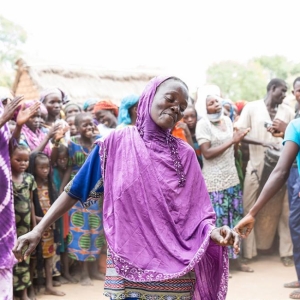Indicators in this domain assess the extent to which migrants have the same status as citizens in terms of access to basic social services such as health, education, and social security. It also describes the rights of migrants to family reunification, to work, and to residency and citizenship. The ratification of the main international conventions is also included within this domain.
Indicators in this category look at the extent to which migrants have access to certain social services such as health, education and social security. They also examine measures to ensure integration and access to work.
Indicators in this domain assess countries’ institutional, legal, and regulatory frameworks related to migration policies. Domain 2 also reviews the existence of national migration strategies that are in-line with development, as well as institutional transparency and coherence in relation to migration management. This domain also investigates the extent to which governments collect and use migration data.
Indicators in this category assess the institutional frameworks of cities for migration. This area also examines the existence of migration strategies consistent with development objectives, as well as institutional transparency and coherence in migration management.
This domain focuses on countries’ efforts to cooperate on migration-related issues with other states and with relevant non-governmental actors, including civil society organizations and the private sector. Cooperation can lead to improvements in governance by aligning and raising standards, increasing dialogue and providing structures to overcome challenges.
Indicators in this category focus on cities’ efforts to cooperate on migration issues with the national government as well as other cities and relevant non-governmental actors, including civil society organizations and the private sector.
This domain includes indicators on countries’ policies for managing the socioeconomic well-being of migrants, through aspects such as the recognition of migrants’ educational and professional qualifications, provisions regulating student migration and the existence of bilateral labour agreements between countries. Indicators equally focus on policies and strategies related to diaspora engagement and migrant remittances.
Indicators in this category assess cities’ initiatives in terms of international student mobility, access to the labour market and decent working conditions for migrant workers. Aspects related to diaspora engagement and migrant remittances are also included in this domain.
This domain studies the type and level of preparedness of countries when they are faced with mobility dimensions of crises, linked to either disasters, the environment and/or conflict. The questions are used to identify the processes in place for nationals and non-nationals both during and after disasters, including whether humanitarian assistance is equally available to migrants as it is to citizens.
Indicators in this category examine the type and level of readiness of cities to deal with aspects of mobility crises. The questions focus on the processes in place for citizens and non-citizens both during and after disasters, especially if humanitarian assistance is available for migrants and citizens.
This domain analyses countries’ approach to migration management in terms of border control and enforcement policies, admission criteria for migrants, preparedness and resilience in the case of significant and unexpected migration flows, as well as the fight against trafficking in human beings and smuggling of migrants. It also assesses efforts and incentives to help integrate returning citizens.
Indicators in this category look at the cities’ approaches to migrant safety as well as return and reintegration policies and the fight against trafficking in persons.
This country Profile describes examples of well-developed areas of the Sri Lanka governance structures and areas with potential for further development, as evaluated through the six domains of the Migration Governance Indicators (MGI). These address migrants’ rights, a “whole-of-government” approach, partnerships, socioeconomic well-being of migrants, the mobility dimensions of crises, and safe and orderly migration.
Click the icons on the wheel to explore the key findings.
The Migration Governance Indicators (MGI) initiative is a policy-benchmarking programme led by the International Organization for Migration (IOM) and implemented with research and analysis from the Economist Impact. Funding is provided by IOM Member States.
Migration governance: Examples of well-developed areas
- The Health Protection Plan is a yearly plan that all residence visa applicants in Sri Lanka must contribute to, and it allows them to access emergency care, primary out-patient health care and disease treatment health benefits at government institutions.
- ‘Re-Imagining Education in Sri Lanka’ (2020) includes “equal and non-discriminatory access to education for all children” among key objectives.
Areas with potential for further development:
- Sri Lankans living abroad are not entitled to vote in national elections from abroad.
- There are no clear rules on indefinite residence for immigrants, and relevant laws do not specify whether foreigners can access indefinite long-term residence permits.
- Only certain categories of migrant workers are entitled to family reunification.
Migration governance: examples of well-developed areas
- The National Policy Framework ‘Vistas of Prosperity and Splendour’ (2020) recognizes the impact of overseas labour migration on national economic development.
- Gender responsiveness is a key guiding principle of the National Labour Migration Policy of 2008.
- The Government has enhanced horizontal policy coherence and institutional coordination for labour migration, border management and human trafficking.
Areas with potential for further development:
- There is no clear and comprehensive institutional and legal framework for managing migration in Sri Lanka.
- The periodic collection and publication of reliable socio-economic data, disaggregated by age, sex and migration status among others, remains an area with potential for further development.
- Mainstreaming migration is limited to certain policies in Sri Lanka.
Migration governance: Examples of well-developed areas
- The Government of Sri Lanka is an active member of Regional Consultative Processes (RCPs) such as the Colombo Process (CP), the Abu Dhabi Dialogue (ADD) and the Bali Process on People Smuggling, Trafficking in Persons and Related Transnational Crime.
- The Government collaborates with civil society organizations on agenda-setting and the implementation of migration-related issues and programs.
- Private recruitment agents represent the private sector on the board of directors of the Sri Lanka Bureau of Foreign Employment.
- The National Advisory Committee on Labour Migration and the National Steering Committee on Return and Re-integration for Labour Migration include representatives from the private and social sectors among its members.
Migration governance: Examples of well-developed areas
- The Sri Lanka Qualifications Framework contributes to the recognition of qualifications from overseas higher education institutions.
- In 2020, the Tertiary and Vocational Education Commission introduced the Skills Passport: a common platform that assesses the compatibility between available vacancies and the profiles of migrant workers.
- The National Policy Framework ‘Vistas of Prosperity and Splendour’ (2020) outlines strategies to promote formal remittance transfer mechanisms through tax exemptions and other incentives.
- The Sri Lanka Bureau of Foreign Employment has introduced regulatory measures throughout the migration cycle to promote ethical recruitment, including a strict screening and licensing system for recruitment agencies, regulating recruitment fees, and setting minimum wages.
Areas with potential for further development:
- There is no monitoring or assessment of labour market needs for different sectors, by types of skills; nor a formal national assessment for monitoring the domestic labour supply and the effects of migration on the domestic labour market.
- Enhanced remittance facilitation is an area with potential for further development.
Migration governance: Examples of well-developed areas
- Programmes of the Sri Lanka Bureau of Foreign Employment provide disaster relief assistance to the families of Sri Lankan migrant workers affected by crisis situations, especially natural disasters.
- The National Policy Framework ‘Vistas of Prosperity and Splendour’ (2020) features housing provision schemes for displaced persons.
- In 2020, the Foreign Ministry launched the online portal Contact Sri Lanka to encourage all overseas Sri Lankans to register voluntarily in order to facilitate its provision of assistance during emergencies.
Areas with potential for further development:
- The Ministry of Environment and its Climate Change Secretariat are developing a policy that addresses the nexus between migration, environmental degradation and climate change (MECC).
- Sri Lanka lacks a comprehensive contingency plan to manage large-scale population movements in times of crisis, as well as a mechanism to get real-time data and information.
Migration governance: Examples of well-developed areas
- The National Border Management Committee implements since 2018 the Sri Lanka Integrated Border Management Strategy.
- The Sub-Policy and National Action Plan on Return and Reintegration of Migrant Workers in Sri Lanka (2015) and the National Policy Framework ‘Vistas of Prosperity and Splendour’ (2020) outline strategies for the reintegration of returning migrants.
- The Sri Lanka Bureau of Foreign Employment maintains a database on all departing Sri Lankan migrant workers for the purpose of protection and welfare service provision.
Areas with potential for further development:
- Intergovernmental coordination and efforts to increase prosecution and investigations against human trafficking could be expanded.
- Initiatives to promote safe and orderly migration and combat migrant labour exploitation, including through effective bilateral agreements/memorandums of understanding with countries of destination, could be strengthened.
2021 December




